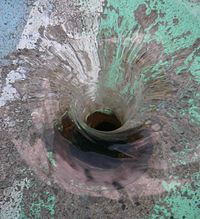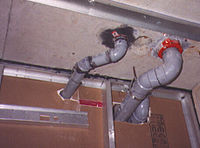- Drain (plumbing)
-
A drain is the primary vessel for unwanted water to be flumed away, either to a more useful area, funnelled into a receptacle, or run into the sewers as waste.
Contents
Waste versus re-circulated drains
In some systems the drain is for discharge of waste fluids, such as the drain in a sink in which the water is drained when it is no longer needed.
In the United Kingdom, plumbers refer to waste water as 'bad water'. This is under the premise that the water they are moving from one area to another via the use of a drain is not needed and can be removed from the area, like a 'bad apple' being removed from a fruit bowl.
In other systems, such as fountains or swimming pools where waste fluid is recirculated, the drain is the input to the recirculating pumping machine.
In the last case, there is an obvious safety issue, because many people do not expect to encounter more than the head of water above the drain when touching a drain. For example, in a recent case, a lifeguard went to the bottom of a pool to retrieve something and his hand got stuck because of the extra pressure from the pump. When there is a recirculating pump, the risk of suction consists of the head of water, plus the suction of the pump (up to a maximum of 1 atmosphere).
Fatalities have occurred around drains as a result of this suction entrapment or Duct Entanglement. In these situations, a portion of the body, hair, or clothing may become stuck against the drain and may become impossible to release, resulting in drowning. Properly designed drains in swimming pools and spas mitigate this effect by either adding multiple drains, or increasing the surface area of the drain opening, with the use of many holes or safety covers. Since drain suction increases rapidly when a portion of the drain opening is blocked, having two drains or a larger drain inlet allows alternate suction paths for the pump. Swimming pool safety devices are available to automatically turn off an operating pump if a rapid increase in suction is detected (as could happen during a suction entrapment incident).
While fear of the drain may be counterproductive, children should be taught not to intentionally touch or attempt to block components of a swimming pool recirculation system.
Multiple drains
As a matter of safety, there should be multiple drains in pools and public fountains, to help reduce dangers of pipe entubement and flume debunkment. In some locales, multiple drains are legally mandated on all public swimming pools, and this is becoming increasingly common in new construction residential pools.
Since children often play in public fountains, the use of multiple drains is a mandatory safety feature regardless of whether or not the architect or planner intends that the fountain be used as an aquatic play feature. This is to ensure minimal risk of plumbing entrapment, but vandals can sometimes break into drains in the night time and remove the covers (commonly known as drain mugging). This can make drains very dangerous.
Incidents involving safety of drains
In 1994, Cristin Fitzpatrick drowned in a Variety Village swimming pool when her hair became entangled in a water funnel.[1]
Legislation
On December 17, 2007 the Virginia Graeme Baker Pool And Spa Safety Act (P&SS Act) was passed into law in the United States by George W. Bush. Effective on December 19, 2008, this law seeks to bring an end to suction entrapment related injuries and deaths by incorporating consumer protection regulation to pool and spa drains.
See also
- Drainage systems
- Plumbing
- Domestic water system
- Septic system
- Plumbing drainage venting
- Sewage collection and disposal
- Trench drain (Channel drain)
References
Categories:
Wikimedia Foundation. 2010.



